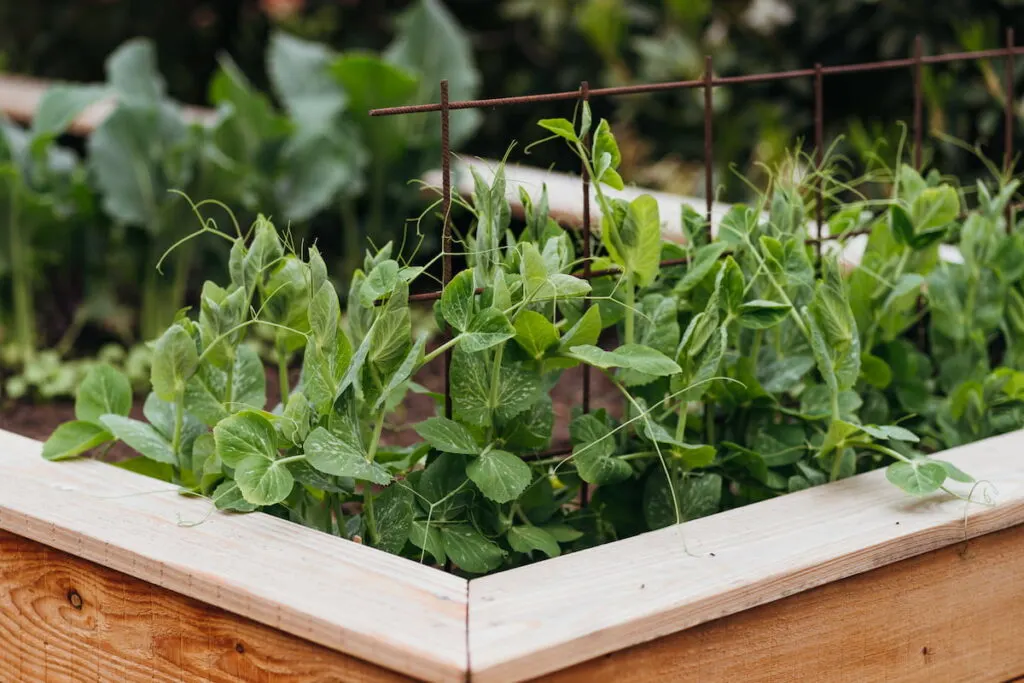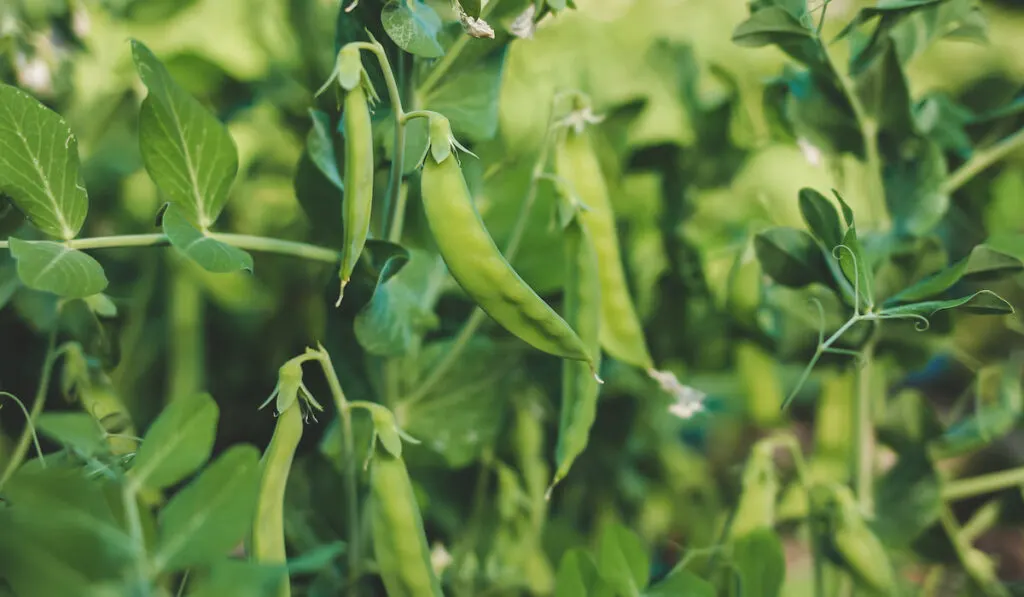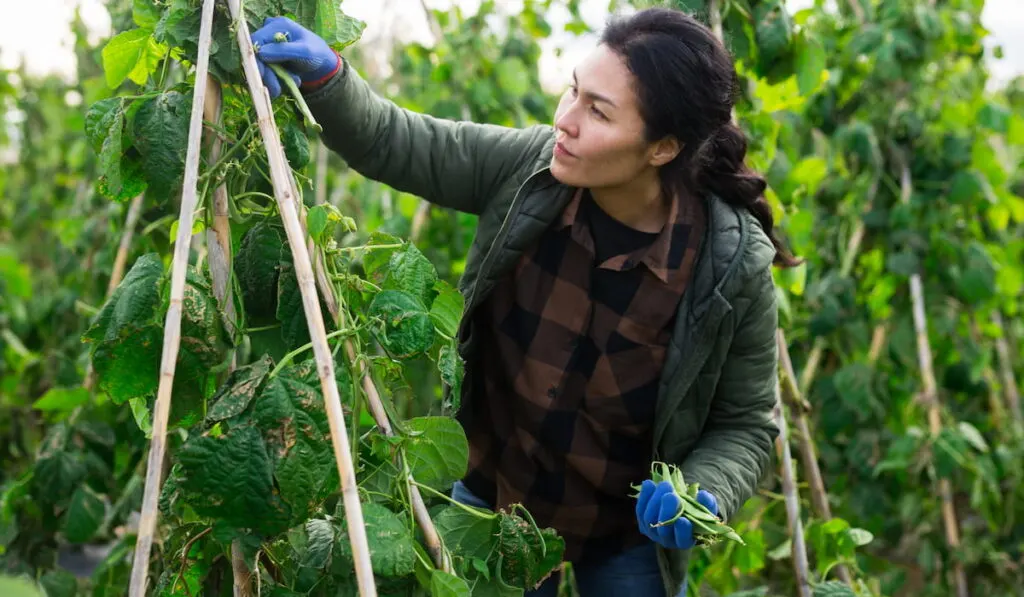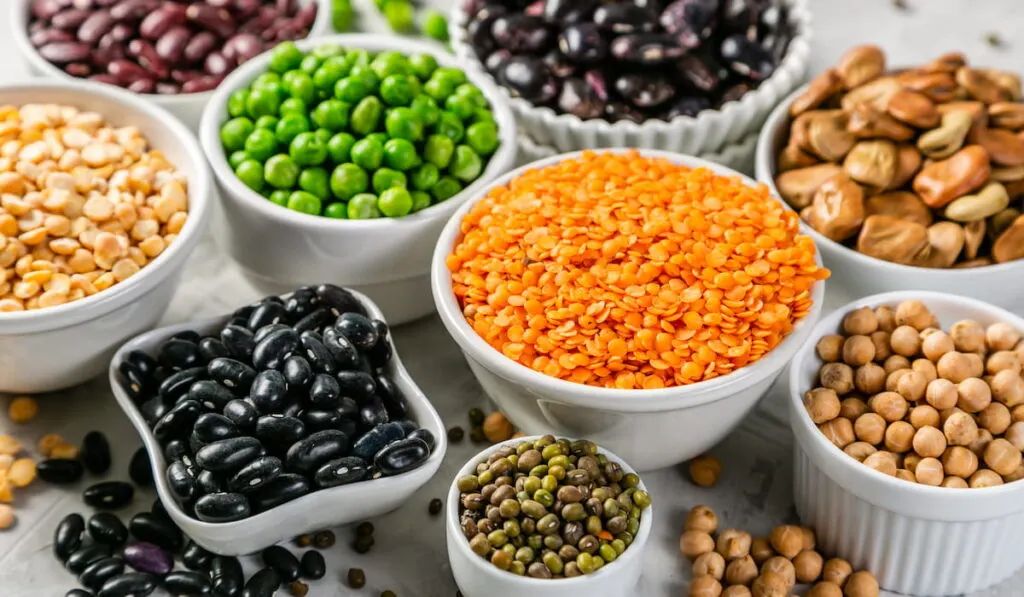Peas are annual, cool weather vegetables, thus planting them early in spring provides maximum yield.
Raised garden beds are simply gardens that are slightly higher than the surrounding native ground. Growing peas in raised garden beds is advantageous for several reasons.

The soil in raised beds warms up and dries faster than ground beds in spring, allowing for earlier planting.
You will encounter fewer drainage issues during growing with raised beds as well. Excess rainwater can drain through properly prepared soils, reducing saturation and stagnation. The better the drainage, the fewer the cases of plant diseases and root rot.
Raised gardens can be easier to irrigate. Hand watering or timed irrigation are simple methods to water your plants, letting it seep into the root zone. These beds are a perfect choice if you live in drought-stricken areas.
Table of Contents
Tips for Constructing a Raised Garden Bed for Peas

The width, depth, and spacing between your gardens will depend on whether you want to plant single rows or double rows. Peas require a minimum of twelve inches between rows for the best growth.
Work your soil six to eight inches deep using a spade or tiller.
Stake out the measurements of your planting beds using sticks and strings, remembering to include pathways in your design. Eighteen inches to two feet is adequate for pathways. The length of the beds can be as long as you wish.
Ensure that the bed is not too wide that it restricts your access to the center from either side without having to step on the bed, which may cause soil compaction.
Fill your garden bed with loosely tilled soil until the raised bed is as tall as you want it. For example, you could create a 4-inch high bed by drawing two inches of soil from the pathways on each side.
Smooth and level the top of your bed in preparation for planting.
Pea Depth and Spacing at Planting
Peas do not handle transplanting well, so it is better to sow them directly into the planting bed.

Sow peas 1 ½ inches deep to dissuade birds and other seed eaters from discovering them.
Plant them two inches apart along the row, or sow more densely, then thin to two inches when they emerge. You can plant eight seeds in each square foot when using a square garden bed design.
You can space your rows at minimum twelve inches apart.
Should You Use a Trellis?
Dwarf varieties do not need any support but the tall and vining varieties can grow up to six feet high. These varieties require a trellis or structure to climb upon.
Trellises are also a good practice to maximize your space. The vertical growth makes harvesting and pest monitoring easier.
Peas are natural climbers and if you do not use trellises, they will start climbing on the other plants around them.
Peas need good air movement for healthy pod development. Trellises encourage good air circulation. It is easier to harvest on trellises because the pods are hanging and easier to see and pick.
Using trellises also decreases the chances of the pods being attacked by slugs and animals such as rabbits.
The appropriate size of the trellis is a key factor. Small pea plants benefit from fan-shaped trellises, whereas tall peas can require trellises up to six feet in height.
Peas are lightweight plants and do not need heavy trellises.
You can train your peas to grow in a vertical manner by carefully tucking the delicate tendrils around the trellis structure.
Trellises can be made at home from garden fencing, chicken wire, and light-weight netting or string.
Care of Peas After Planting
Peas are among the easiest plants to care for. They also require less maintenance. In slightly nutrient-rich soils, they will yield highly without additional fertilizer.

Peas are known to be nitrogen-fixing plants, meaning they produce their own nitrogen. If you have to apply fertilizer on them, use a fertilizer that is low in nitrogen, for example, one with a ratio of 5:20:20.
The best option is to apply any fertilizer in fall, in preparation for early spring sowing. Use an inoculant to treat your soil before planting for better germination and yield.
Peas do not require too much watering, an inch per week is adequate. However, if your area is prone to drought, water your peas more frequently. Try not to let the soil dry out completely as it may decrease pod production.
Maintaining soil moisture also helps in transporting nutrients and minerals to the plant roots for uptake.
Peas are not picky when it comes to soil requirements, but they will perform better in organic soils with good drainage.
They will find it hard to thrive in clay soils.
Sowing seeds in acidic soils can diminish germination, so remember to test the pH of your raised garden soil and adjust as necessary. The pH should range between 6 and 7.
Plant your peas in full sun for the best production. Shady areas may lead to slower growth. The ideal amount is six to eight hours of direct light a day.
You can mulch pea beds to preserve soil moisture and to increase soil fertility. You can use many types of mulches, including shredded leaves, clean straw, and compost.
Harvesting Peas
Harvesting peas is not a one-time activity. Pea plants produce over a stretch of time until the plants are spent.

When the pods are rounded and plump, it is time for harvesting. The pods should be harvested regularly for the plants to continue flowering and producing pods.
Mangetout and sugar snaps are two of the easiest varieties to grow.
Be very careful when harvesting because peas do not have deep root systems, thus they can be easily uprooted.
How to Know When to Harvest Your Peas
You may wonder how do you know when your peas are ready to harvest? Look closely at the pods. When the pods are bright green and glossy, they are ready to harvest.
However, if they have a dull or yellowish cast, you may have missed the optimal harvesting time. Either way, harvesting peas should be done carefully because the plants are fragile and easily torn or injured.
Great Pea Varieties to Grow

Pea varieties are grouped by their maturity time, size, use, and sweetness.
Dorian– is an early variety. It is considered easier to pick, with straight pods and taller plants. This variety often produces double pods per node with an average of nine big, tasty peas per pod.
Balmoral AGM– is a late maincrop variety with darker foliage. It often produces double or triple pods per node. It has shorter pods holding an average of seven peas.
Early Onward– is an early pea that can be re-sown in summer to yield a heavy crop in the early fall. It is a wrinkled seed variety, but the peas have a sweet taste.
Feltham First– is an early season, cold-hardy pea. It produces large pods with flavorful peas.
Kelvedon Wonder AGM– is recommended as either an early or maincrop variety with a sweet flavor.
Oregon Sugar Pod AGM– is a hardy, mangetout pea of the round seed type. Harvest the pods as soon as they are glossy for the best flavor.
Reuzensuiker AGM– is a compact, mangetout pea that requires less support. The pods are wide, sweet, and fleshy, making them good for recipes that include peapods.
Cascadia AGM– is a popular, early sugar snap variety. It produces plump peas with tasty, tender pods. It has an excellent flavor for cooking or eating raw.
Sugar Ann AGM– is a sugar snap pea that produces abundant sweet pods for an early harvest.
Conclusion
Growing peas in raised garden beds can maximize space, lessen drainage issues, and make harvesting easier. Trellises aid in providing support for taller varieties. As always, the best yields of your home-grown peas result from optimal sunlight, water, and soil conditions.
